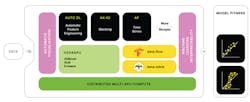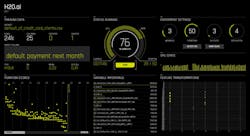Machine learning (ML) is hot, and everyone is using it, or wants to be…sort of. Machine learning is part of the artificial intelligence realm, and the specific area that is of most interest these days is ML based on neural networks—in particular, deep neural networks (DNNs).
These systems can handle inferencing chores that used to be difficult to implement using other techniques. Most involve building a neural network model, training it with lots of data, and then using the trained model as an inferencing engine that can take new data and identify information in the data. These days, that data may be anything from camera images in self-driving cars to natural language analysis of audio data from smart speakers.
Not all ML models and techniques are the same. Likewise, creating and optimizing models often requires expertise that is hard to come by. Many developers take advantage of preexisting models that that fit a particular application, or a design approach that can be used with different training data, but many require custom models or modified models.
H2O.ai’s tools, including its latest Driverless AI (Fig. 1), are designed for non-AI experts so they can create ML models for their applications. It is not quite a matter of providing data and getting a model out the other end, but it is significantly better than getting an AI-related college degree, learning about all the tools, and then building a custom solution.
1. H2O.ai’s Driverless AI architecture can take advantage of distributed, multiple GPU engines to automate the creation of machine learning models that can then be employed for inferencing chores.
Driverless AI provides a streamlined process to creating an ML model that can be used in an application (Fig. 2). The system takes advantage of existing models and provides ways of refining models. This is done by tweaking key variables as opposed to building something from the ground up. Tuning DNNs can be a challenge for non-ML experts.
2. H2O.ai’s Driverless AI dashboard shows that status of the system that is analyzing data to create an optimized machine learning model.
Driverless AI can identify existing models that would work well for an application and allow users to tune those in addition to processing training information. Of course, AI techniques are used within the software to identify and optimize the new models.
One thing that has made neural networks practical has been GPGPU like NVIDIA’s latest DGX-2 that has 16 Tesla V100 GPGPUs tied together with multiple NVSwitch chips. These are necessary because of the amount and type of computation involved, as well as the complexity of the system. Custom AI chips are also being used, but GPGPUs have the flexibility to handle the range of training and inference models that are being created even now.
One of the underlying tools within Driverless AI is H2O.ai’s H2O4GPU. H2O is an open-source, in-memory, distributed, scalable machine learning and predictive analytics platform that runs on conventional GPUs. H2O4GPU provides this functionality on GPUs.
H2O.ai’s Driverless AI targets enterprise applications. Part of the system provides visualization tools that are a key part of assisting the system in developing models that can then be used in an application.
Those wanting to start working with ML may want to experiment with an existing model and application, such as identifying objects within an image, to learn about how some of the tools work. This is relatively easy, but reaching the next plateau from a programming standpoint can be very difficult. Utilizing Driverless AI provides a significantly easier learning curve that can generate useful models without needing to learn about many of the underlying details of model design, optimization, and training.



